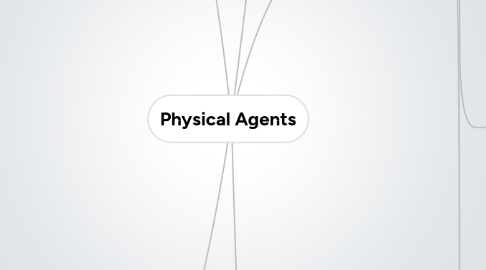
1. Effects of physical agents in the workplace
1.1. PHYSICAL AGENTS - Sources of energy that may cause injury or diesease
1.1.1. AMBIENT - All-encompassing condition associated w/ a given environment, being usually a composite of inputs form sources all around us
1.1.2. Acute - Resulting from a single exposure
2. Thermal Stress
2.1. Thermal stress conditions = hot & cold extremes
2.2. HOMEOSTASIS - The balance of heat generation
2.2.1. Human body = machine that takes in chemical energy (food) and converts it to mechanical energy (muscles) and heat)
2.2.2. Temperature flows from high to low point
2.2.2.1. Adding physical work will increase body heat & shift thermal balance
2.3. Three methods of heat transfer
2.3.1. CONDUCTION - Heat transfer occurring when two surfaces are in contact
2.3.1.1. Ex.stove
2.3.2. CONVECTION - Heat transfer occurring when ones surface adds heat to the surroundings
2.3.2.1. Ex. heater
2.3.3. RADIATION - Heat transfer occurring when energy is transmitted by electronic waves
2.3.3.1. Ex. sun
2.4. Focal point of thermal stress & control = body core - neck to groin & between shoulders
2.5. Heat related illnesses
2.5.1. Heat stroke - Body loses control of thermal balance
2.5.2. Heat hyperpyrexia exhaustion - Body temperature rises
2.5.3. Heat syncope - Heat-induced fainting
2.5.4. Heat exhaustion
2.5.5. Heat cramps
2.5.6. Heat rash
2.5.7. Heat fatigue
2.6. Cold related illnesses
2.6.1. Chilblains - Caused by reduced circulation in extremeties
2.6.2. Trench foot
2.6.3. Frost bite
2.6.4. Hypothermia
3. Radiation
3.1. Two types, identified by wavelength range
3.1.1. Ionizing radiation
3.1.1.1. Electromagnetic energy capable of producing ions through interaction w/ matter
3.1.1.1.1. X-rays (common in medical facilities)
3.1.1.1.2. Gamma rays, alpha particles, beta particles, neutrons (common in nuclear plants & research companies)
3.1.1.2. Measured in rem (roentgen equivalent man)
3.1.1.3. Biological effects depend on whether exposure is whole body or local. acute or chronic
3.1.1.4. Control of exposure will include regular monitoring, shielding, job rotation, protective equipment, extensive training
3.1.2. Non-ionizing radiation
3.1.2.1. Electromagnetic radiation that does not have energies great enough to ionize matter
3.1.2.1.1. UV radiation
3.1.2.1.2. Visible (white light) radiation
3.1.2.1.3. Inferred radiation
3.1.2.1.4. Microwave radiation
3.1.2.1.5. Radio waves
3.1.2.2. Sun can be a source of all radiations
3.1.2.3. Eye = primary organ at risk
3.1.2.4. Control usually includes isolation separation, protective equipment & training
4. Noise
4.1. Noise - Any unwanted sound - Standards of measurement: decibel (dB)
4.1.1. Decibels measured on logarithmic scale
4.1.2. Major loss occurs gradually over 5-10 years
4.2. THRESHOLD OF HEARING - Range of sound that human ear can perceive or hear
4.2.1. We don't hear everything in a nice, neat way
4.2.2. Just because we can't gear he sound doesn't mean it is not present
4.2.3. Human hearing response depends on three characteristics
4.2.3.1. Frequency
4.2.3.1.1. Certain frequencies = damaging
4.2.3.2. Duration
4.2.3.2.1. Longer sounds louder
4.2.3.3. Loudness
4.2.3.3.1. Louder = more problematic
4.3. EARLY WARNING CHANGE - A deterioration of hearing in the upper frequency - the earliest detectable sign of noise-induced hearing loss
4.4. Noise can cause
4.4.1. Physiological damage that affects hearing
4.4.1.1. Conductive hearing loss
4.4.1.1.1. Restricts transmission of sound to cochlea or inner ear
4.4.1.2. Sensorineural hearing loss (nerve deafness)
4.4.1.2.1. Affects the cochlea & is usually irreversible
4.4.1.2.2. More prevalent in industry
4.4.1.2.3. Hearing aids less helpful
4.4.2. More general physiological effects
4.4.2.1. Startled response to noise, cardiovascular, neurologic, endocrine, biochemical changes, nausea, malaise, headaches
4.4.2.1.1. VASOCONSTRICTION - The process of causing a constriction of the blood vessels
4.4.2.1.2. HYPERREFLEXIA - The condition of unusually quick reaction by the nerves to some external stimulus
4.4.3. Psychological effects
4.4.3.1. Selective hearing
4.5. Types of hearing loss
4.5.1. Temporary threshold shift (TTS)
4.5.1.1. Gradual hearing loss
4.5.1.2. Sometimes reversible by removal from noise source
4.5.2. Permanent threshold shift (PTS)
4.5.2.1. Permanent hearing disability
4.6. Noise exposure standards
4.6.1. Dose - Amount of noise absorbed or impinged on an organ
4.6.2. EXCHANGE RATE - Represents the doubling of the sound power
4.6.3. Can vary across provinces & territories
4.6.4. Continuous nose have different standards than impact/impulse noise
4.6.5. Tools used in noise exposure tests
4.6.5.1. SOUND PRESSURE LEVEL METER - Measures gross noise level
4.6.5.2. OCTAVE BAND ANALYZER - Measures the noise level in each frequency range
4.6.5.3. DOSIMETER - Measures a person's exposure to noise as a percentage for one shift
4.6.5.4. AUDIOMETER - An instrument used to determine the sensitivity of a person's hearing or degree of hearing loss
4.7. Noise control
4.7.1. Process for noise control follows source-path-human strategies
4.7.1.1. Source
4.7.1.1.1. Make source quieter
4.7.1.2. Path
4.7.1.2.1. Move worker away from source and/or erect sound barriers b/w noise & worker
4.7.1.2.2. As the distance from the source is doubled, the noise will drop by a fixed amount
4.7.1.2.3. ATTENUATED OR ATTENUATION - Reduction of noise at one location compared to another farther from the source
4.7.1.2.4. Less costly than source
4.7.1.3. Human
4.7.1.3.1. Involves use of PPE
4.7.1.3.2. Least costly & most commonly used
4.7.1.3.3. Not always the best method, used in conjunction w/ other methods
4.7.1.3.4. Many companies not well informed to undertake other approaches
5. Vibration
5.1. VIBRATION - Oscillating motion of the bodying moving about a reference position
5.1.1. Health hazard for three reasons
5.1.1.1. WHOLE BODY VIBRATION - Affects the whole body as a unit
5.1.1.1.1. Health effects
5.1.1.1.2. Causes
5.1.1.2. SEGMENTAL VIBRATION - Affects only parts of the body
5.1.1.2.1. Health effects
5.1.1.2.2. Causes
5.1.1.3. Noise
5.1.2. Medium usually solid
5.1.3. Two catehories
5.1.3.1. Low frequency
5.1.3.2. High frequency
5.1.3.2.1. Happens so fast body cannot respond
5.1.3.2.2. Velocity & acceleration
5.1.4. Vibration can be dampened by increasing mass or weight
